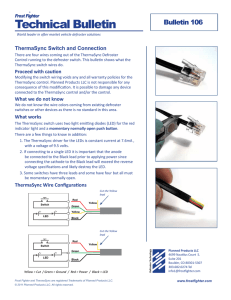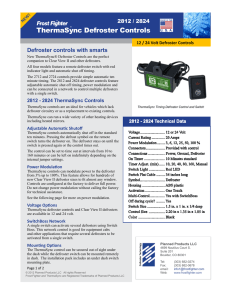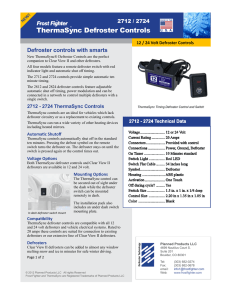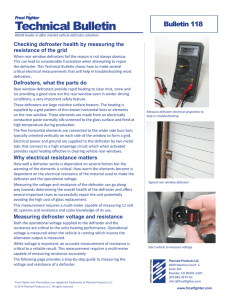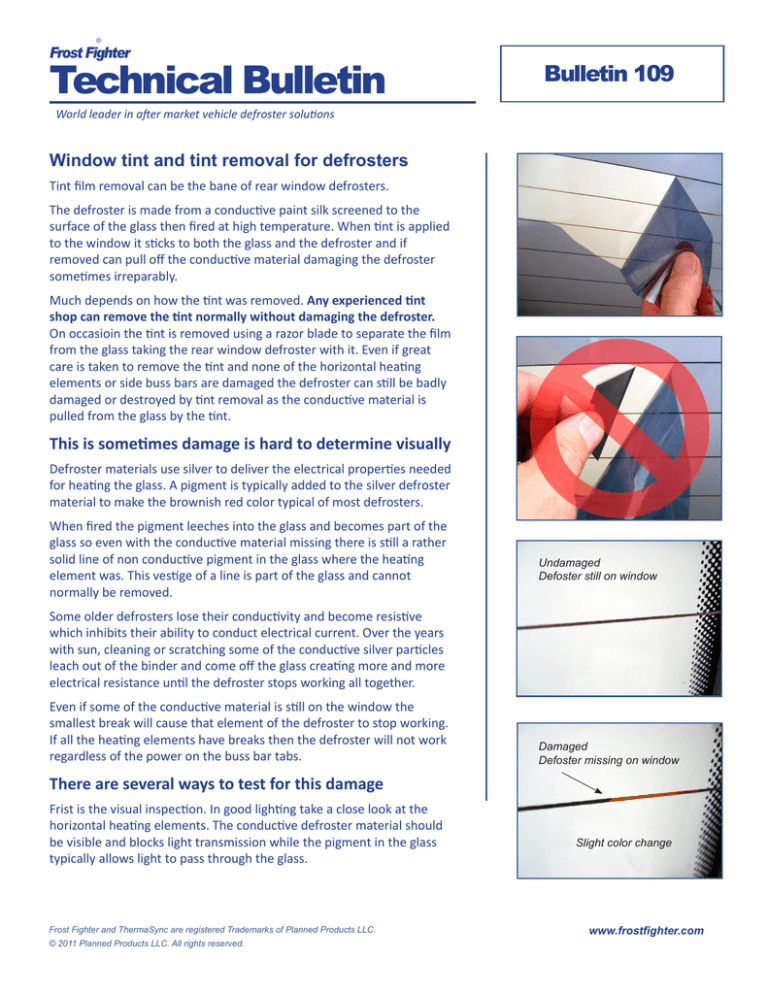
®
Frost Fighter
Technical Bulletin
Bulletin 109
World leader in after market vehicle defroster solutions
Window tint and tint removal for defrosters
Tint film removal can be the bane of rear window defrosters.
The defroster is made from a conductive paint silk screened to the
surface of the glass then fired at high temperature. When tint is applied
to the window it sticks to both the glass and the defroster and if
removed can pull off the conductive material damaging the defroster
sometimes irreparably.
Much depends on how the tint was removed. Any experienced tint
shop can remove the tint normally without damaging the defroster.
On occasioin the tint is removed using a razor blade to separate the film
from the glass taking the rear window defroster with it. Even if great
care is taken to remove the tint and none of the horizontal heating
elements or side buss bars are damaged the defroster can still be badly
damaged or destroyed by tint removal as the conductive material is
pulled from the glass by the tint.
This is sometimes damage is hard to determine visually
Defroster materials use silver to deliver the electrical properties needed
for heating the glass. A pigment is typically added to the silver defroster
material to make the brownish red color typical of most defrosters.
When fired the pigment leeches into the glass and becomes part of the
glass so even with the conductive material missing there is still a rather
solid line of non conductive pigment in the glass where the heating
element was. This vestige of a line is part of the glass and cannot
normally be removed.
Undamaged
Defoster still on window
Some older defrosters lose their conductivity and become resistive
which inhibits their ability to conduct electrical current. Over the years
with sun, cleaning or scratching some of the conductive silver particles
leach out of the binder and come off the glass creating more and more
electrical resistance until the defroster stops working all together.
Even if some of the conductive material is still on the window the
smallest break will cause that element of the defroster to stop working.
If all the heating elements have breaks then the defroster will not work
regardless of the power on the buss bar tabs.
Damaged
Defoster missing on window
There are several ways to test for this damage
Frist is the visual inspection. In good lighting take a close look at the
horizontal heating elements. The conductive defroster material should
be visible and blocks light transmission while the pigment in the glass
typically allows light to pass through the glass.
Frost Fighter and ThermaSync are registered Trademarks of Planned Products LLC.
© 2011 Planned Products LLC. All rights reserved.
Slight color change
www.frostfighter.com
In addition the defroster conductor has a physical presence on the glass
so there should be a tiny bump on the glass surface that can be felt
when moving your finger across the grid line. If everything is perfectly
smooth then it’s a good bet the defroster is missing.
Testing with multi-meter or test light
The best way to trouble shoot defrosters is with a multi-meter or trouble
light. The first thing to do is determine if the defroster is getting power.
Turn on the defroster and connect the probes from the multi-meter or
test light to the metal tabs typically on each side of the defroster. You
should see 12-13 volts when measured from tab to tab. If no power
is indicated then the problem is with the vehicles defroster circuitry.
Assuming there is power on the tabs, next test from the base of each
metal tab to the defroster surface next to the tab. You should see
good continuity between the tab and the defroster surface. It would
be unusual if there was not a good connection between the tab and
the defroster without the tab being loose or disconnected from the
defroster.
Now with the defroster
off and the tab connectors
removed, test the
continuity between the
tabs themselves. A good
multi-meter is useful here.
Again place the probes on
the multi-meter on each
tab and set the meter to
measure continuity rather
than voltage. You should
see some continuity
between the tabs. If the reading is zero for no continuity between the
defrosters tabs this is a clear indication the defroster is badly damaged.
If there is some continuity between the tabs then it is time to start
testing individual heating elements for breaks.
Turn on the defroster and connect one lead of the multi-meter to the
positive tab on the defroster. Next move move the probe along the grids
to locate a break. Be very careful not to damage the grid line with the
probe. A good trick is to use a small length of tin foil connected to the
multi-meter’s probe as the contact. When the probe passes over a break
you will see a sharp change in the reading.
These breaks can be repaired with the Frost Fighter 2100 Defroster Grid
Repair Kit. A good methodology is to repair the breaks you can see with
visual inspection and then use the multi-meter or test lamp to identify
any other damage. This is not an all or nothing repair. Fix a few grid lines
and then test the defroster and repair a few more. The 2100 grid kit a
repair kit and not designed to restore complete defrosters. Replacement
defrosters are available as the Clear View II defrosters.
Frost Fighter and ThermaSync are registered Trademarks of Planned Products LLC.
© 2011 Planned Products LLC. All rights reserved.
Planned Products LLC
4699 Nautilus Court S.
Suite 201
Boulder, CO 80301-5307
303.682.0274 Tel
info1@frostfighter.com
www.frostfighter.com

